
Why Your Pet's Dinner Might Be Causing Their Itchiness
If your pet is constantly itchy, miserable, and lacking joy, it's time to take a closer look at what’s in their bowl. Surprisingly, the source of their discomfort could stem from their daily diet. Many owners are discovering that traditional protein sources such as chicken, beef, and lamb might be the culprits triggering skin irritations and digestive woes.
The Magic of Novel Proteins
Novel proteins are unique animal (or in some cases, plant) proteins that your dog hasn’t been exposed to before. Transitioning to these alternative proteins can significantly alleviate food sensitivities. Conditions like constant itching, red irritated skin, and even chronic digestive issues can improve remarkably by simply changing up your pet's protein sources.
Understanding Food Sensitivities in Dogs
Recent trends show a worrying rise in food sensitivities among dogs of all ages—puppies, young adults, and senior pets alike. Proteins, especially chicken, have become frequent culprits in this growing issue, as repeated exposure can lead to the immune system recognizing them as threats. This can evoke allergic reactions that manifest as discomfort, including:
- Excessive scratching and licking
- Ear infections
- Digestive issues, like gurgling stomach and diarrhea
- Anal gland problems
Don’t be fooled by complacency: a dog may appear tolerant to a specific food for years and then suddenly develop sensitivities. This unpredictable nature of food allergies highlights the importance of transitioning to novel proteins.
Foods To Consider: A New Palette for Your Pup
Opting for less common protein sources can rejuvenate your dog's health. Here are a few novel proteins that might do the trick:
- Duck
- Rabbit
- Venison
- Fish
- Quail
By rotating these proteins, you not only offer a diverse nutritional profile but also assist in maintaining your pet’s immune system and keeping sensitivities at bay.
Making the Transition
Moving to a new diet takes care and caution. A sudden switch can lead to further digestive upset, so always transition gradually. Start by mixing small amounts of the novel protein with their current food and slowly increase the new protein while decreasing the old. This helps your pet’s gastrointestinal system adjust without negative consequences.
Eco-Friendly Choices for Pet Owners
Interestingly, many novel protein sources, such as rabbit and venison, tend to have a smaller environmental footprint than conventional protein sources. This aspect not only benefits your pet’s health but can also align with the growing desire among pet owners to make environmentally conscious decisions in their purchasing habits.
Understand Your Pet’s Unique Needs
Every dog is unique, and understanding their specific sensitivities and preferences is crucial. Consulting with pet health professionals can provide tailored guidance and further enhance the well-being of your furry friend. Moreover, keeping a food diary can help you track reactions and pinpoint allergens.
Final Thoughts and Wellness Goals
Your dog’s comfort and happiness are paramount, and a simple adjustment in diet could be the key to their wellness. The prospect of using novel proteins brings not only the hope of alleviating their discomfort but also an exciting opportunity to enrich their nutritional profile. With vigilant awareness, patience, and care, you can help your beloved pet thrive.
 Add Row
Add Row  Add
Add 




Write A Comment